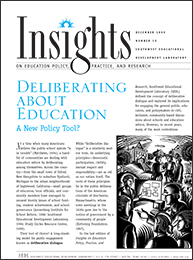Deliberating About Education: A New Policy Tool?
Introduction

At a time when many Americans believe the public school system “is in trouble” (Matthews, 1996), a handful of communities are dealing with education reform by deliberating among themselves. Across the country—from the small town of Orford, New Hampshire to suburban Ypsilanti, Michigan to the urban neighborhoods of Inglewood, California—small groups of educators, local officials, and community members have managed to unravel knotty issues of school funding, student achievement, and school governance (Annenberg Institute for School Reform, 1998; Southwest Educational Development Laboratory, 1996; Study Circles Resource Center, 1999).
Their tool of choice? A long-standing model for public engagement known as deliberative dialogue. While “deliberative dialogue” is a relatively modern term, its underlying principles—democratic participation, civility, mutual respect and responsibility—are as old as our nation itself. The roots of these principles lie in the public deliberations of the American colonists of Dorchester, Massachusetts, whose town meetings in the 1630s gave rise to the notion of government by a community of people (Kettering Foundation, 1997).
Table
Primary Sources of Information
Legislators Use in Policy Decision Making
| Constituents | 36.5% |
| Experts in the specific policy area | 20.2% |
| Staff analysts or advisors | 18.7% |
| Lobbyists or special interest groups | 15.0% |
| Other sources | 9.6% |
In the last edition of Insights on Education Policy, Practice, and Research, Southwest Educational Development Laboratory (SEDL) defined the concept of deliberative dialogue and explored its implications for engaging the general public, educators, and policymakers in civil, inclusive, community-based discussions about schools and education reform. However, in recent years, many of the most contentious education policy debates have centered on reforms that are initiated not at the local but rather the state level: school choice, standards-based student assessment, and school funding equity. Indeed, the depth and ardor of public sentiment over these issues have often come as a great surprise to state legislators, governors, and departments of education—suggesting that their traditional means of understanding their constituents and the public at large may be insufficient (Mutchler, 1993). In this edition of Insights, SEDL examines the nature of the deliberative dialogue process within the wider, state policy context—exploring its potential as a communications tool among state policymakers and the public.
The first-person accounts presented in this Insights were gathered during interviews in early 1998 from eight state policymakers who have engaged in deliberative dialogues with constituents. Seven legislators in Florida, Oklahoma, and Pennsylvania and one elected state official in Connecticut had participated in either study circles or National Issues Forums1 about issues ranging from criminal justice to tort reform to race relations (Mutchler & Knox, 1998). Analysis of these interviews contributed to the design of a study of impacts of community-wide deliberative dialogue on state education policymaking. That research study, completed by SEDL in 1999, focused specifically on the experiences of Arkansas and Oklahoma state policymakers who participated in community-wide study circles about education in fall 1998.
Next Page: How Do State Policymakers interact with the Public?

